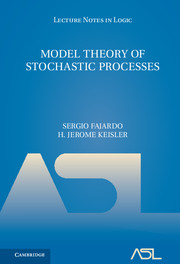Book contents
- Frontmatter
- Dedication
- Contents
- Introduction
- Chapter 1 Adapted distributions
- Chapter 2 Hyperfinite adapted spaces
- Chapter 3 Saturated spaces
- Chapter 4 Comparing stochastic processes
- Chapter 5 Definability in adapted spaces
- Chapter 6 Elementary extensions
- Chapter 7 Rich adapted spaces
- Chapter 8 Adapted neometric spaces
- Chapter 9 Enlarging saturated spaces
- References
- Index
Chapter 7 - Rich adapted spaces
Published online by Cambridge University Press: 30 March 2017
- Frontmatter
- Dedication
- Contents
- Introduction
- Chapter 1 Adapted distributions
- Chapter 2 Hyperfinite adapted spaces
- Chapter 3 Saturated spaces
- Chapter 4 Comparing stochastic processes
- Chapter 5 Definability in adapted spaces
- Chapter 6 Elementary extensions
- Chapter 7 Rich adapted spaces
- Chapter 8 Adapted neometric spaces
- Chapter 9 Enlarging saturated spaces
- References
- Index
Summary
In the preceding chapterswe have often used the adjective “rich” to describe the powerful properties of saturated and hyperfinite adapted spaces. In this chapter we formally introduce the mathematical notion of a rich adapted space and prove three main theorems about them (in these theorems we allow filtrations which are not necessarily right continuous): (1)With a countable time line, an adapted space is rich if and only if it is saturated. (2) Every atomless adapted Loeb space is rich. (3) For every rich adapted space with the real time line, the corresponding right continuous adapted space is saturated. This will show that all atomless adapted Loeb spaces are saturated. In the next chapter we will see that rich adapted spaces have some strong properties which quickly lead to a variety of applications in probability theory.
Many applications of nonstandard analysis take the following form, sometimes called the lifting procedure. Start with a problem stated in standard terms. Lift everything in sight up to the nonstandardworld. Construct a sequence of internal approximate solutions of some kind indexed by the natural numbers. Use the Saturation Principle to extend the sequence through the hyperintegers. Finally, take object number H where H is a sufficiently small infinite hyperinteger, and come back down to the standard world to get a solution of the original problem. Nonstandard arguments of this sort are similar to standard compactness arguments, but can work in cases where a compactness argument fails. There are several examples of the lifting procedure in Chapter 2.
The lifting procedure is well known to workers in the field. Unfortunately, to those mathematicians not familiar with the theory, the beauty and power of these techniques remains a complete mystery. One way to address this issue is to try to convince experts of the value of nonstandard analysis, so that they are encouraged to study it and then be able to use it. One tries to present interesting results so that the experts in the field will dare to look closely at them. But predictably, these efforts have encountered resistance. For a related discussion of these issues consult Keisler [1991], Keisler [1994].
Information
- Type
- Chapter
- Information
- Model Theory of Stochastic Processes , pp. 99 - 114Publisher: Cambridge University PressPrint publication year: 2002
